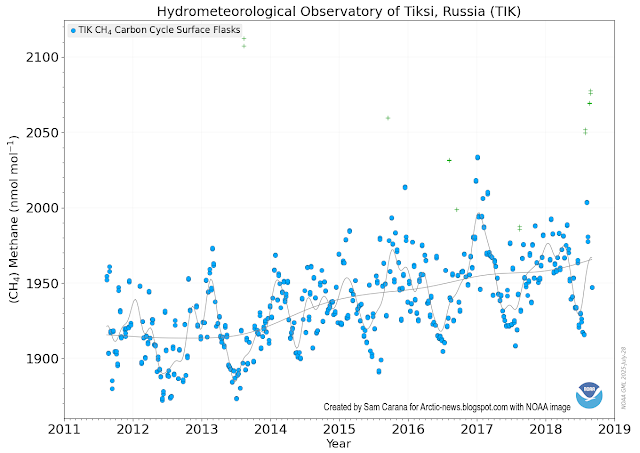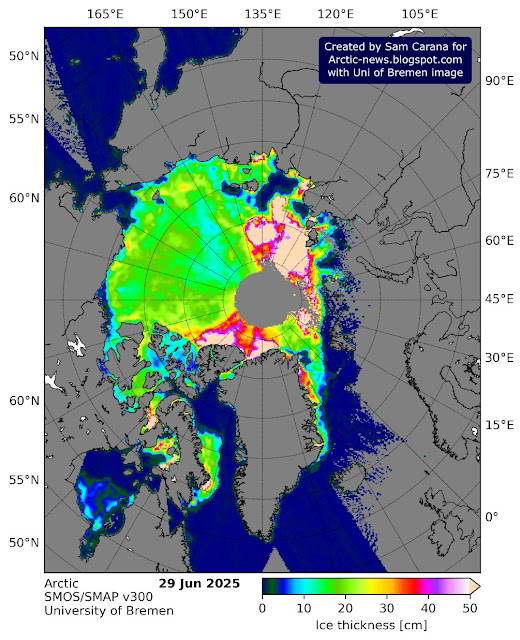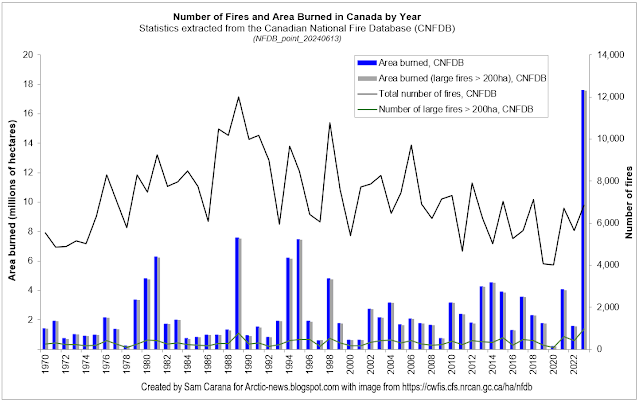Arctic sea ice area reached an annual minimum of 2.70 million km² on September 9, 2025, the fourth-lowest minimum area, as illustrated by the image below. The low Arctic sea ice area is worrying, especially when considering that this minimum was reached in the absence of El Niño conditions. Lower air temperatures are now causing rapid growth of Arctic sea area, which is sealing off the Arctic Ocean and this makes it more difficult for ocean heat to be transferred to the atmosphere. Furthermore, Arctic sea ice volume was at a record daily low on September 16, 2025, as it has been for more than a year, as illustrated by the image below.
More ocean heat could therefore reach sediments at the seafloor of the Arctic Ocean, which threatens to destabilize hydrates and cause huge amounts of methane to be released. Eruption of methane from the seafloor of the Arctic Ocean is one of the most dangerous feedbacks of rising temperatures. As the seafloor of the Arctic Ocean heats up, heat can penetrate sediments and cause destabilization of hydrates, resulting in eruption of methane. Since the seas in the Arctic Ocean can be very shallow, methane eruptions can occur abruptly, with great force and in the form of plumes, leaving little opportunity for the methane to get decomposed in the water. Furthermore, there is very little hydroxyl in the air over the Arctic, which extends the lifetime of methane over the Arctic.
The above image illustrates the danger. Sea ice constitutes a buffer that previously consumed much incoming ocean heat (left); as sea ice thins, the buffer disappears while more heat also enters the Arctic Ocean (right). Further heat entering the Arctic Ocean from the Atlantic Ocean and the Pacific Ocean threatens to destabilize sediments that contain methane, causing eruption of huge amounts of methane.
The danger is also illustrated by the image below, adapted from an image issued by NOAA September 18, 2025, showing hourly methane averages recorded at the Barrow Atmospheric Baseline Observatory (BRW), a NOAA facility located near Utqiaġvik (formerly Barrow), Alaska, at 71.32 degrees North.
Antarctic sea ice area reached an annual maximum of 13.73 million km² on September 5, 2025, a deviation from 1981-2010 of -2.08σ, as illustrated by the image below.
Sea ice area is low at both poles, despite the absence of El Niño conditions. Low global sea ice area causes more sunlight to get absorbed by the ocean. Global sea ice area was 2.40 million km² below the 1981-2010 mean on September 16, 2025, a deviation from 1981-2010 of 3.91σ.
A study by Duspayev et al. (2024) calculates that global sea ice has lost 13%–15% of its planetary cooling effect since the early/mid 1980s, corresponding with an implied global sea ice albedo feedback of 0.24–0.38 W m⁻² K⁻¹.
The IPCC has failed to warn about Antarctic sea ice decline, and - importantly - the amplifying impact of Antarctic sea ice decline on the global temperature rise. This was addressed in a 2023 post as follows:
Sea ice loss results in less sunlight getting reflected back into space and instead getting absorbed by the ocean and the impact of Antarctic sea ice loss is even stronger than Arctic sea ice loss, since Antarctic sea ice is located closer to the Equator, as pointed out by Paul Beckwith in a video in an earlier post [and in the video below]. A warmer Southern Ocean also comes with fewer bright clouds, further reducing albedo, as discussed here and here. For decades, there still were many lower clouds over the Southern Ocean, reflecting much sunlight back into space, but these lower clouds have been decreasing over time, further speeding up the amount of sunlight getting absorbed by the water of the Southern Ocean, and this 'pattern effect' could make a huge difference globally, as this study points out. Emissivity is a further factor; open oceans are less efficient than sea ice when it comes to emitting in the far-infrared region of the spectrum (feedback #23 on the feedbacks page).
 |
| [ The Buffer is gone, from Accelerating Temperature Rise ] |
The danger is also illustrated by the image below, adapted from an image issued by NOAA September 18, 2025, showing hourly methane averages recorded at the Barrow Atmospheric Baseline Observatory (BRW), a NOAA facility located near Utqiaġvik (formerly Barrow), Alaska, at 71.32 degrees North.
Antarctic sea ice area reached an annual maximum of 13.73 million km² on September 5, 2025, a deviation from 1981-2010 of -2.08σ, as illustrated by the image below.
Loss of sea ice area results in less sunlight getting reflected back into space and instead more heat getting absorbed by the ocean.
 |
| [ image from earlier post ] |
With sea ice area low at both poles, global sea ice area could fall further over the next few months, thus causing even more sunlight to get absorbed by the ocean and threatening to cause an Antarctic Blue Ocean Event early 2026.
On March 1, 2025, Antarctic sea ice area reached an annual minimum of 1.21 million km², almost as low as the 1.09 million km² reached on February 22, 2023 (highlighted), as illustrated by the image below.
A study by Duspayev et al. (2024) calculates that global sea ice has lost 13%–15% of its planetary cooling effect since the early/mid 1980s, corresponding with an implied global sea ice albedo feedback of 0.24–0.38 W m⁻² K⁻¹.
Sea ice loss results in less sunlight getting reflected back into space and instead getting absorbed by the ocean and the impact of Antarctic sea ice loss is even stronger than Arctic sea ice loss, since Antarctic sea ice is located closer to the Equator, as pointed out by Paul Beckwith in a video in an earlier post [and in the video below]. A warmer Southern Ocean also comes with fewer bright clouds, further reducing albedo, as discussed here and here. For decades, there still were many lower clouds over the Southern Ocean, reflecting much sunlight back into space, but these lower clouds have been decreasing over time, further speeding up the amount of sunlight getting absorbed by the water of the Southern Ocean, and this 'pattern effect' could make a huge difference globally, as this study points out. Emissivity is a further factor; open oceans are less efficient than sea ice when it comes to emitting in the far-infrared region of the spectrum (feedback #23 on the feedbacks page).
In the video below, Paul Beckwith discusses the situation in Antarctica.
An Antarctic Blue Ocean Event early 2026 would further accelerate the global temperature rise, thus likely causing an Arctic Blue Ocean Event as well later in 2026. Further increasing this danger is the potential for an El Niño to emerge in the course of 2026.
Climate Emergency Declaration
The situation is dire and the precautionary principle calls for rapid, comprehensive and effective action to reduce the damage and to improve the situation, as described in this 2022 post, where needed in combination with a Climate Emergency Declaration, as discussed at this group.
Links
• Kevin Pluck - Sea ice visuals
https://seaice.visuals.earth
• Danish Meteorological Institute - Arctic sea ice thickness and volume
https://ocean.dmi.dk/arctic/icethickness/thk.uk.php
• NOAA - Global Monitoring Laboratory - Data Visualisation - flask and station methane measurements
https://gml.noaa.gov/dv/iadv
• Transforming Society
https://arctic-news.blogspot.com/2022/10/transforming-society.html
• Climate Plan
https://arctic-news.blogspot.com/p/climateplan.html
• Climate Emergency Declaration
https://arctic-news.blogspot.com/p/climate-emergency-declaration.html
The situation is dire and the precautionary principle calls for rapid, comprehensive and effective action to reduce the damage and to improve the situation, as described in this 2022 post, where needed in combination with a Climate Emergency Declaration, as discussed at this group.
Links
• Kevin Pluck - Sea ice visuals
https://seaice.visuals.earth
• Danish Meteorological Institute - Arctic sea ice thickness and volume
https://ocean.dmi.dk/arctic/icethickness/thk.uk.php
• NOAA - Global Monitoring Laboratory - Data Visualisation - flask and station methane measurements
https://gml.noaa.gov/dv/iadv
• Transforming Society
https://arctic-news.blogspot.com/2022/10/transforming-society.html
• Climate Plan
https://arctic-news.blogspot.com/p/climateplan.html
• Climate Emergency Declaration
https://arctic-news.blogspot.com/p/climate-emergency-declaration.html







































































